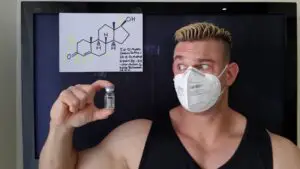Medical Screening required before your First Cycle
Before you consider using Performance Enhancing Drugs (PEDs), which are often a lifetime commitment, please take the effort and spend the money on high-quality health screening. KNOWING what you need to pay attention too, while using PEDs, ultimately determines the success of your First Cycle, and every cycle following it.
Listen to this Articles YouTube Video
Blood Work Screening
In order to get a baseline reading of your current state of health, and assess what your hormone levels look like, before taking endocrinology into your own hands, make sure you test the following markers. Markers labeled with an asterisk * can be considered optional, they aren’t mandatory before a first cycle, but highly informative of your current state of health nonetheless.
Drink at least 1 to 1.5 liters of water before drawing blood for analysis. This rules out dehydration on your blood work results. Slight dehydration can alter your Red Blood Cell Count, Hematocrit, Creatinine, and Electrolytes levels, tipping the scale between what’s considered normal, and borderline unhealthy.
General Body Details
• Age; years
• Height; cm or feet & inch
• Blood Pressure; Systolic (mm Hg) over Diastolic (mm Hg)
• Body Weight; kg or lb
• Body Fat Level; %
• Waist Circumference; cm or inch
Complete Blood Count
• Hematocrit; %
• Red Blood Cell (RBC) Count; Mcells/mm^3
• Red Blood Cell Distribution Width (RDW); %
• Red Blood Cell Morphology
• Anisocytosis; present?
• Micro- & Macrocytes; present?
• Hypochromia; present?
• Platelet Count: Cells/mm^3
• Platelet from Smear; adequate?
• Hemoglobin; g/dL or mmol/L
• Mean Corpuscular Volume (MCV); μm^3 or fL
• Mean Corpuscular Hemoglobin (MCH); pg/cell or fmol/cell
• Mean Corpuscular Hemoglobin Concentration (MCHC); g/dL or mmol/L
• White Blood Cell (WBC) Count; Cells/mm^3
White Blood Cell Differential
• Neutrophil (PMN); %
• Lymphocyte; %
• Monocyte; %
• Eosinophil; %
• Basophil; %
Complete Blood Count Relevant Markers
• Serum Iron; μg/dL or μmol/L
• Total Iron Binding Capacity (TIBC)*; μg/dL or μmol/L
• Serum Ferritin; ng/mL or nmol/L
• Transferrin*; mg/dL or mmol/L
• Transferrin Saturation*; %
• Hemoglobin A1C; %
Blood Chemistry
• Total Cholesterol; mg/dL or mmol/L
• Triglycerides; mg/dL or mmol/L
• High Density Lipoprotein (HDL); mg/dL or mmol/L
• Low Density Lipoprotein (LDL); mg/dL or mmol/L
• very-Low Density Lipoprotein (v-LDL)*; mg/dL or mmol/L
• Apolipoprotein A (apoA)*; mg/dL or mmol/L
• Apolipoprotein B (apoB)*; mg/dL or mmol/L
• Lipoprotein little(a) (LP(a))*; mg/dL or μmol/L
• High Sensitivity; C-Reactive Protein (hs;CRP); mg/L or nmol/L
• Homocysteine (HcyH); mg/L or μmol/L
• Fasted Blood Sugar; mg/dL or mmol/L
Kidney Function
• Blood Urea Nitrogen (BUN); mg/dL or mmol/L
• Creatinine (Cr); mg/dL or μmol/L
• Creatine Phosphate Kinase (CPK); U/L or μkat/L
• Cystatin-C (Cys-C)*; mg/L or nmol/L
• Uric Acid; mg/dL or μmol/L
• eGFR; mL/min per 1.73 m2
Serum Electrolytes
• Sodium (Na+)*; mEq/L or mmol/L
• Potassium (K+)*; mEq/L or mmol/L
• Chloride (Cl-)*; mEq/L or mmol/L
• BiCarbonate (HCO3 / CO2)*; mEq/L or mmol/L
• Magnesium (Mg+)*; mEq/L or mmol/L
• Calcium (Ca+)*; mEq/L or mmol/L
Liver Function
• Total Protein; g/dL
• Albumin; g/dL
• Globulin; g/dL
• Albumin to Globulin Ratio; calculated
• Alkaline Phosphate; U/L or μkat/L
• Total Bilirubin; mg/dL or μmol/L
• Direct Bilirubin; mg/dL or μmol/L
• Serum Glutamic-Oxaloacetic Transaminase (SGOT/AST); U/L or μkat/L
• Serum Glutamic-Pyruvic Transaminase (SGPT/ALT); U/L or μkat/L
• Gamma-Glutamyl Transferase (Gamma-GT); U/L or μkat/L
Urinalysis Panel
• Color
• Appearance
• Specific Gravity (Sp.Gr)
• Ph Level
• Protein, Glucose, Ketones, Bilirubin, Urobilinogen, Nitrite & Blood; present?
• RBC, WBC (Leukocytes) & Epithelial Cells Levels; Cells/HPF
• Bacteria; present?
Hormones
• Estrone (E1)*; pg/mL or pmol/L
• Estradiol (E2); pg/mL or pmol/L
• Estriol (E3)*; pg/mL or pmol/L
• Prolactin (PRL); ng/mL or nmol/L
• Progesterone (P4)*; ng/mL or nmol/L
• Pregnenolone (Preg)*; ng/dL or nmol/L
• Pregnenolone-Sulfate (Preg-S)*; μg/dL or μmol/L
• DeHydroEpiAndrosterone (DHEA)*; ng/mL or nmol/L
• DeHydroEpiAndrosterone-Sulfate (DHEA-S); μg/dL or μmol/L
• Total Testosterone; ng/dL or nmol/L
• Free Testosterone; ng/dL or nmol/L
• Bio-Available Testosterone; ng/dL or nmol/L
• DiHydroTestosterone (DHT)*; ng/dL or nmol/L
• Sex Hormone Binding Globulin (SHBG); μg/mL or nmol/L
• Luteinizing Hormone (LH); mIU/mL or IU/L
• Follicle-Stimulating Hormone (FSH); mIU/mL or IU/L
• Fasting Serum Cortisol*; μg/dL or nmol/L
• Fasting Serum Insulin*; μIU/mL or pmol/L
• Fasting Serum Growth Hormone (GH)*; ng/mL or μg/L
• Serum Insulin-Like Growth Factor-1 (IGF-1)*; ng/mL or nmol/L
Thyroid
• Total Triiodothyronine (T3)*; ng/dL or nmol/L
• Free Triiodothyronine (fT3); pg/mL or pmol/L
• Reverse Triiodothyronine (rT3)*; ng/dL or nmol/L
• Total Thyroxine (T4)*; μg/dL or nmol/L
• Free Thyroxine (fT4); ng/dL or pmol/L
• Thyroid-Stimulating Hormone (TSH); mIU/L
Nutrient Deficiency
• 1,25-Dihydroxy Vitamin D3*; pg/mL or pmol/L
• 25-Hydroxy Vitamin D*; ng/mL or nmol/L
• Zinc*; µg/mL or µmol/L
• Copper*; µg/mL or µmol/L
• Selenium*; ng/mL or nmol/L
• Vitamin B12 / Cobalamin*; ng/L
• Vitamin B9 / Folate / Folic Acid*; ng/mL
Heavy Metal Screening
• Aluminum*; µg/dL
• Arsenic*; µg/L
• Cadmium*; µg/L
• Chromium*; µg/L
• Lead*; µg/dL
• Mercury*; µg/dL
Cancer Marker Screening
Exogenous recombinant human Growth Hormone (rhGH), Insulin-like Growth Factor-1 (IGF-1), Thymosin beta-4 (Tb-4), TB-500, BPC-157, or GW-501516 (Cardarine) do not directly cause cancer or tumors. However, they can accelerate the progression of pre-existing cancer & tumors tremendously. Before you consider adding exogenous Growth Hormone, IGF-1, or other peptides to your PED protocol, you should check the following cancer markers:
• Alpha-Fetoprotein (AFP); ng/mL
• Cancer Antigen 15-3 (CA 15-3); U/mL
• Cancer Antigen 19-9 (CA 19-9); U/mL
• Cancer Antigen 125 (CA 125) / MUC-16; U/mL
• Carcino-Embryonic Antigen (CEA); ng/mL
• Ferritin; ng/mL
• beta-Human Chorionic Gonadotropin (β-HCG); mIU/mL
• Human Growth Hormone (hGH); ng/mL
• Neuron-Specific Enolase (NSE); ng/mL
• Free-Prostate Specific Antigen (f-PSA); ng/mL
• Prostatic-Specific Acid Phosphatase (PSAP / ACPP) Protein; ng/mL
• Prostate-Specific Antigen (PSA); ng/mL
Coach Steve HIGHLY advises every enhanced bodybuilder, strength athlete, or fitness enthusiast to check these cancer markers every 3 years, more often if possible and affordable. If there are known cases of specific cancers within your family history or determined through genetic analysis, please review their related Cancer Marker yearly while using exogenous rhGH or IGF-1, no matter how low the dose!
Below is a list of organs and their related Cancer Markers:
• Breast: CA 15-3, CA 125, CEA, Ferritin & β-HCG.
• Colorectal: CA 19-9 & CEA.
• Endometrium: CA 15-3,Ferritin, f-PSA, PSA & PSAP / ACPP
• Esophagus: CA 19-9
• Liver: AFP, CA 19-9, CA 125, Ferritin, f-PSA, PSA & PSAP / ACPP
• Lung: CEA, Ferritin, NSE, f-PSA, PSA & PSAP / ACPP
• Ovary: AFP, CA 15-3, CA 125 & β-HCG.
• Pancreas: AFP, CA 19-9, CEA, Ferritin, NSE, f-PSA, PSA & PSAP / ACPP.
• Pituitary: hGH
• Prostate: β-HCG, f-PSA, PSA & PSAP / ACPP.
• Stomach: CA 19-9, CEA & AFP.
• Testicles: AFP, β-HCG
• Thyroid: NSE
• Uterus: CA 125
Almost all pituitary tumors (adenomas) are benign glandular tumors. These tumors are classified as benign because they don’t spread to other parts of the body, as seen with certain forms of cancers. Still, even benign Pituitary tumors can cause significant health problems because they are close to the brain and may invade nearby tissues, including the skull or the sinuses. Benign pituitary tumors or adenomas often produce excessive amounts of growth hormone, luteinizing hormone, follicle-stimulating hormone, or Prolactin, resulting in acromegaly, erectile dysfunction, or gynecomastia. Suppose your pituitary hormone levels are very high before starting your first cycle, then it’s HIGHLY advised to take a biopsy of your pituitary gland to assess if certain functional adenomas have formed.
Pituitary cancers (carcinomas) are very rare.
Semen Analysis
Consider analyzing your semen quality and fertility levels, before using Anabolic-Androgenic Steroids (AAS) or Selective Androgen Receptor Modulators (SARMs). These compounds downregulate your Hypothalamic-Pituitary-Testes-Axis (HPTA) and Hypothalamic-Pituitary-Adrenal-Axis (HPAA), or completely shut it down during prolonged exposure. A semen analysis before your first cycle helps to determine your baseline fertility levels, which you should attempt to recover before you’re ready to conceive and have children later on in life.
Assuming your fertility levels are normal and fall within healthy parameters, consider freezing your semen for later use. Ideally, you freeze multiple samples at different hospitals or clinics which offer this service, to ensure that healthy and fertile semen is (immediately) available when you’re ready to conceive.
Abstain from intercourse or masturbation for 3 days prior to your semen analysis, which could otherwise negatively affect your ejaculate volume. A semen analysis reports the following parameters:
• Semen / Ejaculate Volume; mL
• Total Sperm Count in Ejaculate; million sperm
• Sperm Concentration; million sperm/mL
• Total Motility; %
• Progressive Motility; %
• Sperm Morphology; %








